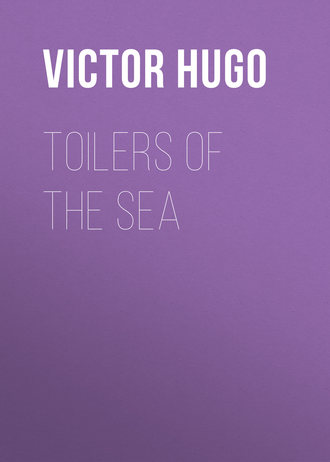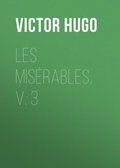
Виктор Мари Гюго
Toilers of the Sea
INTRODUCTION
Victor Hugo was thinking much of Æschylus and his Prometheus at the time he conceived the figure of Gilliatt, heroic warrer with the elements. But it is to a creature of the Gothic mind like Byron's Manfred, and not to any earlier, or classic, type of the eternal rebellion against fate or time or circumstance, that Hugo's readers will be tempted to turn for the fellow to his Guernsey hero:
"My joy was in the wilderness – to breathe
The difficult air of the iced mountain's top,
Where the birds dare not build – nor insects wing
Flit o'er the herbless granite; or to plunge
Into the torrent, and to roll along
On the swift whirl of the new-breaking wave
Of river-stream, or ocean, in their flow."
The island of Guernsey was Gilliatt's Alp and sea-solitude, where he, too, had his avalanches waiting to fall "like foam from the round ocean of old Hell." And as Byron figured his own revolt against the bonds in Manfred, so Hugo, being in exile, put himself with lyrical and rhetorical impetuosity into the island marcou and child of destiny that he concocted with "a little sand and a little blood and a deal of fantasy" in the years 1864 and 1865. There is a familiar glimpse of the Hugo household to be had in the first winter of its transference to the Channel Islands, years before Les Travailleurs was written, which betrays the mood from which finally sprang this concrete fable of the man-at-odds. It was the end of November 1852, and a father and his younger son sat in a room of a house of Marine Terrace, Jersey – a plain, unpicturesque house; square, hard in outline, and newly whitewashed, – Methodism, said Hugo, in stones and mortar. Outside its windows the rain fell and the wind blew: the house was like a thing benumbed by the angry noise. The two inmates sat plunged in thought, possibly thinking of the sad significance of these beginnings of winter and of exile which had arrived together. At length the son (François Hugo) asked the father what he meant to do during their exile, which he had already predicted would be long? The father said, "I shall look at the sea." Then came a silence, broken by a question as to what the son would do? To which he replied that he would translate Shakespeare.
Victor Hugo's own study or eulogy of Shakespeare was written as a preamble to his son's translation of the plays. It is not too much to connect the new and ample creative work that followed, including his great novel of Revolution, Les Misérables, and his poems in La Légende des Siècles (first series) with the double artistic stimulus gained from this conditioned solitude and his closer acquaintance with the dramatic mind of that "giant of the great art of the ages," as he termed our English poet in the book already quoted from.
The Shakespeare book is dated from Hauteville House, 1864. Les Travailleurs from the same quarters, March 1866. The Hugos had perforce suddenly left Jersey for Guernsey in 1855, owing to the gibes and flouts of an unlucky revolutionary Jersey journal, L'Homme, at the two governments: Victor Hugo being already a marked man for his pains. The Guernsey house he inhabited for so many years had a spacious study in its upper story, with a large window, free to the sun and to the sea. Here he wrote, tirelessly, tremendously, as his custom was: beginning betimes in the early morning, and writing on till the time for his déjeuner: standing at a tall desk to write in his sea-tower. You must turn to certain of his poems and to the pages of Les Misérables and Les Travailleurs for the mental colours and phantasmagoria of those days and years.
It would be easy to point out, resuming an immense amount of criticism of his romances and of this story in particular, the defects on the side of dramatic and true life-likeness to be found in Hugo's prose-narrative. But it is more helpful in turning to a story-book to know what has been said unreservedly in its favour. Hugo's greatest appreciator was superlative in his praise, and it need hardly be explained that it was Swinburne who brought his tribute to the romance of Gilliatt also, after positing the parallel claims of Hugo's five chief romances. Of the five, they were not, he said, to be comparatively classified in order of merit. "But I may perhaps be permitted to say without fear of deserved rebuke that none is to me personally a treasure of greater price than Les Travailleurs de la Mer. The splendid energy of the book makes the superhuman energy of the hero seem not only possible but natural, and his triumph over all physical impossibilities not only natural but inevitable." Swinburne's love for the Channel Islands, and his poems inspired by them, were mainly due as we know to Hugo's life and his books lived and written there.
E.R.
The following is a list of the chief publications of Victor Hugo: —
Poetical Works: – Nouvelles Odes, 1824; Odes et Poésies Diverses, 1822; Odes et Ballades, 1826; Les Orientales, 1829; Feuilles d'Automne, 1831; Les Chants du Crépuscule, 1835; Les Voix Intérieures, 1837; Les Rayons et les Ombres, 1840; Odes sur Napoléon, 1840; Les Châtiments, 1853; Les Contemplations, 1856; La Légende des Siècles (1st part), 1859; Les Chansons des Rues et des Bois, 1865; L'Année Terrible, 1872; La Légende des Siècles (2nd part), 1877; L'Art d'être Grand-père, 1877; Le Pape, 1878; La Pitié Suprême, 1879; L'Âne, 1880; Religion et Religions, 1880; Les Quatre Vents de l'Esprit, 1881; La Légende des Siècles (3rd part), 1883.
Dramatic Works: – Cromwell, 1827; Amy Robsart, 1828; Hernani, 1830; Marion Delorme, 1831; Le Roi s'amuse, 1832; Lucrèce Borgia, 1833; Marie Tudor, 1833; Angelo, Tyran de Padoue, 1835; La Esmeralda (libretto for Opera), 1836; Ruy Blas, 1838; Burgraves, 1843; Torquemada, 1882.
Novels and other Prose Works: – Hans d'Islande, 1823; Bug-Jargal (enlarged for book form), 1826; Le Dernier Jour d'un Condamné, 1829; Notre-Dame de Paris, 1831; Étude sur Mirabeau, 1834; Claude Gueux, 1834; Le Rhin, 1842; Napoléon le Petit, 1852; Les Misérables, 1862; Littérature et Philosophie mélées, 1864; William Shakespeare, 1864; Les Travailleurs de la Mer, 1866; L'Homme qui rit, 1869; Actes et Paroles, 1872; Quatre-Vingt-Treize, 1873; Histoire d'un Crime, 1877; Discours pour Voltaire, 1878; Le Domaine public payant, 1878; L'Archipel de la Manche, 1883.
Hugo left a mass of manuscripts, of which some have been published since his death: – Le Théatre en Liberté, La Fin de Satan, Dieu, Choses Vues, Tonte la Lyre, Océan, En Voyage, Postscriptum de ma Vie.
An Edition Définitive of his works in 48 volumes was published 1880-5.
Translations: – Of novels, 28 vols., 1895, 1899, etc.; of dramas, by I.G. Burnham, 1895. Separate translations of prose and poetical works.
Life: – Among the biographies and appreciations are: – Sainte-Beuve, Biographie des Contemporains, vol. iv., 1831; Portraits Contemporains, vol. i., 1846; Victor Hugo raconté par un témoin de sa vie (Madame Hugo), 1863; A. Barbou, 1880 (trans. 1881); E. Biré, Victor Hugo avant 1830, 1883; après 1830, 1891; après 1852, 1894; F.W.H. Myers, Essays, 1883; Paul de Saint Victor, 1885, 1892; Alfred Asseline, Victor Hugo intime, 1885; G.B. Smith, 1885; J. Cappon, A Memoir and a Study, 1885; A.C. Swinburne, A Study of Victor Hugo, 1886; E. Dupuy, Victor Hugo, l'homme et le poète, 1886; F.T. Marzials (Great Writers), 1888; Charles Renouvier, Victor Hugo le Poète, 1892; L. Mabilleau, 1893; J.P. Nichol, 1893; C. Renouvier, Victor Hugo le Philosophe, 1900; E. Rigal, 1900; G.V. Hugo, Mon Grand-père, 1902; Juana Lesclide, Victor Hugo intime, 1902; Theophile Gautier, 1902; F. Gregh, Étude sur Victor Hugo, 1905; P. Stapfers, Victor Hugo à Guernsey, 1905.
PREFACE
Religion, Society, and Nature! these are the three struggles of man. They constitute at the same time his three needs. He has need of a faith; hence the temple. He must create; hence the city. He must live; hence the plough and the ship. But these three solutions comprise three perpetual conflicts. The mysterious difficulty of life results from all three. Man strives with obstacles under the form of superstition, under the form of prejudice, and under the form of the elements. A triple ἁναγκη weighs upon us. There is the fatality of dogmas, the oppression of human laws, the inexorability of nature. In Notre Dame de Paris the author denounced the first; in the Misérables he exemplified the second; in this book he indicates the third. With these three fatalities mingles that inward fatality – the supreme ἁναγκη, the human heart.
Hauteville House,
March, 1866.
PART I. – SIEUR CLUBIN
BOOK I
THE HISTORY OF A BAD REPUTATION
I
A WORD WRITTEN ON A WHITE PAGE
Christmas Day in the year 182- was somewhat remarkable in the island of Guernsey. Snow fell on that day. In the Channel Islands a frosty winter is uncommon, and a fall of snow is an event.
On that Christmas morning, the road which skirts the seashore from St. Peter's Port to the Vale was clothed in white. From midnight till the break of day the snow had been falling. Towards nine o'clock, a little after the rising of the wintry sun, as it was too early yet for the Church of England folks to go to St. Sampson's, or for the Wesleyans to repair to Eldad Chapel, the road was almost deserted. Throughout that portion of the highway which separates the first from the second tower, only three foot-passengers could be seen. These were a child, a man, and a woman. Walking at a distance from each other, these wayfarers had no visible connection. The child, a boy of about eight years old, had stopped, and was looking curiously at the wintry scene. The man walked behind the woman, at a distance of about a hundred paces. Like her he was coming from the direction of the church of St. Sampson. The appearance of the man, who was still young, was something between that of a workman and a sailor. He wore his working-day clothes – a kind of Guernsey shirt of coarse brown stuff, and trousers partly concealed by tarpaulin leggings – a costume which seemed to indicate that, notwithstanding the holy day, he was going to no place of worship. His heavy shoes of rough leather, with their soles covered with large nails, left upon the snow, as he walked, a print more like that of a prison lock than the foot of a man. The woman, on the contrary, was evidently dressed for church. She wore a large mantle of black silk, wadded, under which she had coquettishly adjusted a dress of Irish poplin, trimmed alternately with white and pink; but for her red stockings, she might have been taken for a Parisian. She walked on with a light and free step, so little suggestive of the burden of life that it might easily be seen that she was young. Her movements possessed that subtle grace which indicates the most delicate of all transitions – that soft intermingling, as it were, of two twilights – the passage from the condition of a child to that of womanhood. The man seemed to take no heed of her.
Suddenly, near a group of oaks at the corner of a field, and at the spot called the Basses Maisons, she turned, and the movement seemed to attract the attention of the man. She stopped, seemed to reflect a moment, then stooped, and the man fancied that he could discern that she was tracing with her finger some letters in the snow. Then she rose again, went on her way at a quicker pace, turned once more, this time smiling, and disappeared to the left of the roadway, by the footpath under the hedges which leads to the Ivy Castle. When she had turned for the second time, the man had recognised her as Déruchette, a charming girl of that neighbourhood.
The man felt no need of quickening his pace; and some minutes later he found himself near the group of oaks. Already he had ceased to think of the vanished Déruchette; and if, at that moment, a porpoise had appeared above the water, or a robin had caught his eye in the hedges, it is probable that he would have passed on his way. But it happened that his eyes were fixed upon the ground; his gaze fell mechanically upon the spot where the girl had stopped. Two little footprints were there plainly visible; and beside them he read this word, evidently written by her in the snow —
"GILLIATT."
It was his own name.
He lingered for awhile motionless, looking at the letters, the little footprints, and the snow; and then walked on, evidently in a thoughtful mood.
II
THE BÛ DE LA RUE
Gilliatt lived in the parish of St. Sampson. He was not liked by his neighbours; and there were reasons for that fact.
To begin with, he lived in a queer kind of "haunted" dwelling. In the islands of Jersey and Guernsey, sometimes in the country, but often in streets with many inhabitants, you will come upon a house the entrance to which is completely barricaded. Holly bushes obstruct the doorway, hideous boards, with nails, conceal the windows below; while the casements of the upper stories are neither closed nor open: for all the window-frames are barred, but the glass is broken. If there is a little yard, grass grows between its stones; and the parapet of its wall is crumbling away. If there is a garden, it is choked with nettles, brambles, and hemlock, and strange insects abound in it. The chimneys are cracked, the roof is falling in; so much as can be seen from without of the rooms presents a dismantled appearance. The woodwork is rotten; the stone mildewed. The paper of the walls has dropped away and hangs loose, until it presents a history of the bygone fashions of paper-hangings – the scrawling patterns of the time of the Empire, the crescent-shaped draperies of the Directory, the balustrades and pillars of the days of Louis XVI. The thick draperies of cobwebs, filled with flies, indicate the quiet reign long enjoyed by innumerable spiders. Sometimes a broken jug may be noticed on a shelf. Such houses are considered to be haunted. Satan is popularly believed to visit them by night. Houses are like the human beings who inhabit them. They become to their former selves what the corpse is to the living body. A superstitious belief among the people is sufficient to reduce them to this state of death. Then their aspect is terrible. These ghostly houses are common in the Channel Islands.
The rural and maritime populations are easily moved with notions of the active agency of the powers of evil. Among the Channel Isles, and on the neighbouring coast of France, the ideas of the people on this subject are deeply rooted. In their view, Beelzebub has his ministers in all parts of the earth. It is certain that Belphegor is the ambassador from the infernal regions in France, Hutgin in Italy, Belial in Turkey, Thamuz in Spain, Martinet in Switzerland, and Mammon in England. Satan is an Emperor just like any other: a sort of Satan Cæsar. His establishment is well organised. Dagon is grand almoner, Succor Benoth chief of the Eunuchs; Asmodeus, banker at the gaming-table; Kobal, manager of the theatre, and Verdelet, grand-master of the ceremonies. Nybbas is the court-fool; Wierus, a savant, a good strygologue, and a man of much learning in demonology, calls Nybbas the great parodist.
The Norman fishermen, who frequent the Channel, have many precautions to take at sea, by reason of the illusions with which Satan environs them. It has long been an article of popular faith, that Saint Maclou inhabited the great square rock called Ortach, in the sea between Aurigny and the Casquets; and many old sailors used to declare that they had often seen him there, seated and reading in a book. Accordingly the sailors, as they passed, were in the habit of kneeling many times before the Ortach rock, until the day when the fable was destroyed, and the truth took its place. For it has been discovered, and is now well established, that the lonely inhabitant of the rock is not a saint, but a devil. This evil spirit, whose name is Jochmus, had the impudence to pass himself off, for many centuries, as Saint Maclou. Even the Church herself is not proof against snares of this kind. The demons Raguhel, Oribel, and Tobiel, were regarded as saints until the year 745; when Pope Zachary, having at length exposed them, turned them out of saintly company. This sort of weeding of the saintly calendar is certainly very useful; but it can only be practised by very accomplished judges of devils and their ways.
The old inhabitants of these parts relate – though all this refers to bygone times – that the Catholic population of the Norman Archipelago was once, though quite involuntarily, even in more intimate correspondence with the powers of darkness than the Huguenots themselves. How this happened, however, we do not pretend to say; but it is certain that the people suffered considerable annoyance from this cause. It appears that Satan had taken a fancy to the Catholics, and sought their company a good deal; a circumstance which has given rise to the belief that the devil is more Catholic than Protestant. One of his most insufferable familiarities consisted in paying nocturnal visits to married Catholics in bed, just at the moment when the husband had fallen fast asleep, and the wife had begun to doze; a fruitful source of domestic trouble. Patouillet was of opinion that a faithful biography of Voltaire ought not to be without some allusion to this practice of the evil one. The truth of all this is perfectly well known, and described in the forms of excommunication in the rubric de erroribus nocturnis et de semine diabolorum. The practice was raging particularly at St. Helier's towards the end of the last century, probably as a punishment for the Revolution; for the evil consequences of revolutionary excesses are incalculable. However this may have been, it is certain that this possibility of a visit from the demon at night, when it is impossible to see distinctly, or even in slumber, caused much embarrassment among orthodox dames. The idea of giving to the world a Voltaire was by no means a pleasant one. One of these, in some anxiety, consulted her confessor on this extremely difficult subject, and the best mode for timely discovery of the cheat. The confessor replied, "In order to be sure that it is your husband by your side, and not a demon, place your hand upon his head. If you find horns, you may be sure there is something wrong." But this test was far from satisfactory to the worthy dame.
Gilliatt's house had been haunted, but it was no longer in that condition; it was for that reason, however, only regarded with more suspicion. No one learned in demonology can be unaware of the fact that, when a sorcerer has installed himself in a haunted dwelling, the devil considers the house sufficiently occupied, and is polite enough to abstain from visiting there, unless called in, like the doctor, on some special occasion.
This house was known by the name of the Bû de la Rue. It was situated at the extremity of a little promontory, rather of rock than of land, forming a small harbourage apart in the creek of Houmet Paradis. The water at this spot is deep. The house stood quite alone upon the point, almost separated from the island, and with just sufficient ground about it for a small garden, which was sometimes inundated by the high tides. Between the port of St. Sampson and the creek of Houmet Paradis, rises a steep hill, surmounted by the block of towers covered with ivy, and known as Vale Castle, or the Château de l'Archange; so that, at St. Sampson, the Bû de la Rue was shut out from sight.
Nothing is commoner than sorcerers in Guernsey. They exercise their profession in certain parishes, in profound indifference to the enlightenment of the nineteenth century. Some of their practices are downright criminal. They set gold boiling, they gather herbs at midnight, they cast sinister looks upon the people's cattle. When the people consult them they send for bottles containing "water of the sick," and they are heard to mutter mysteriously, "the water has a sad look." In March, 1857, one of them discovered, in water of this kind, seven demons. They are universally feared. Another only lately bewitched a baker "as well as his oven." Another had the diabolical wickedness to wafer and seal up envelopes "containing nothing inside." Another went so far as to have on a shelf three bottles labelled "B." These monstrous facts are well authenticated. Some of these sorcerers are obliging, and for two or three guineas will take on themselves the complaint from which you are suffering. Then they are seen to roll upon their beds, and to groan with pain; and while they are in these agonies the believer exclaims, "There! I am well again." Others cure all kinds of diseases, by merely tying a handkerchief round the patient's loins, a remedy so simple that it is astonishing that no one had yet thought of it. In the last century, the Cour Royale of Guernsey bound such folks upon a heap of fagots and burnt them alive. In these days it condemns them to eight weeks' imprisonment; four weeks on bread and water, and the remainder of the term in solitary confinement. Amant alterna catenæ.
The last instance of burning sorcerers in Guernsey took place in 1747. The city authorities devoted one of its squares, the Carrefour du Bordage, to that ceremony. Between 1565 and 1700, eleven sorcerers thus suffered at this spot. As a rule the criminals made confession of their guilt. Torture was used to assist their confession. The Carrefour du Bordage has indeed rendered many other services to society and religion. It was here that heretics were brought to the stake. Under Queen Mary, among other Huguenots burnt here, were a mother and two daughters. The name of this mother was Perrotine Massy. One of the daughters was enceinte, and was delivered of a child even in the midst of the flames. As the old chronicle expresses it, "Son ventre éclata." The new-born infant rolled out of the fiery furnace. A man named House took it in his arms; but Helier Gosselin the bailli, like a good Catholic as he was, sternly commanded the child to be cast again into the fire.






